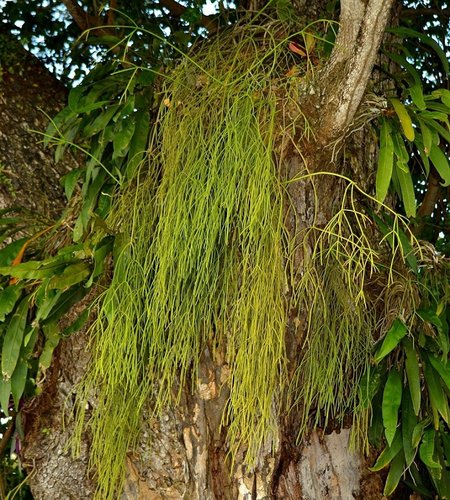Postby TriP » December 20th, 2014, 3:01 am
Local Christmas ~ Under the Mistletoe
As Christmas Day draws near, no doubt many people are busy cleaning, shopping and going about their various Christmas traditions.
There are, of course, many foreign traditions which we have adopted or we are at least aware of, and many readers would be familiar with the use of Mistletoe at Christmas.
But did you know that we have our very own Mistletoe right here in Trinidad and Tobago?
Perhaps the plant we most commonly think of as Mistletoe is the Old Man’s Beard (Rhipsalis sp.). This is a very common Epiphyte which can be found growing on trees throughout the country.
The Long, Green, String-like clumps are a familiar sight on large trees like the Samaan trees around the Queen’s Park Savannah.
The old man’s beard grows on the surface of other plants but it is important to note that it is not a parasite as it does not directly harm the tree as true parasites do.
However, Old Man’s Beards may sometimes indirectly harm a host if the sheer weight of plants causes damage to the host plant or if it manages to block sunlight from reaching lower leaves.
Like other Epiphytes, the Old Man’s Beard helps add to the diversity of life which can inhabit a host tree by creating more niches for wildlife.
It produces small white fruits which are attractive to several birds including the familiar semp and cravat (both euphonias).
Other birds may construct their nests in the dangling stems. Many invertebrates undoubtedly make their homes in the root mass which attaches the cactus to the host.
While we sometimes refer to it as mistletoe, the old man’s beard is not related to the mistletoe family.
True Mistletoes are Parasitic Vines belonging to the taxonomic order of Santalales.
These plants will actually tap into the food supply of the host plant, thus depriving the host of needed nutrients.
The Old Man’s Beard, on the other hand is actually a type of Cactus! At this point, it should be noted that the name old man’s beard is commonly used for a variety of unrelated plant species across the world.
Before the proliferation of artificial ornaments, this simple plant was sometimes used to decorate homes at Christmas time.
Easy to find, free and fairly long lasting, the old man’s beard also had a natural hanging form which facilitated hanging above the door and porch.
It could then be decorated further with paint, ribbons and bows. Unfortunately, the popularity of this tradition faded as foreign glass, metal and then plastic ornaments became affordable and convenient.
While the old man’s beard is not a true mistletoe, we actually do have native mistletoe species, it’s just that you may not notice them easily unless you look for them.
At least two species belonging to the Taxa Loranthus and Phthirusa can be found on trees locally and are colloquially known as “bird vine” or “vage”.
These plants also produce berries on which birds feed, hence their common name.
They are true parasites and can damage their host trees.
In fact, the threat posed by these parasitic bird vines to tree crops was considered severe enough that the plant was declared a pest which, by law, was to be destroyed if found!
But despite this assault, these plants still thrive in our woodlands.
Indeed you can rest assure that Trini mistletoes will live on in the wild where it will continue to decorate our forest and enhance the wondrous biodiversity of our land.
-
Attachments
-



